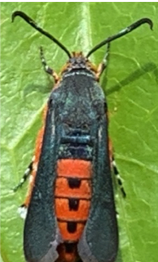Row Covers for Garden Defense
go.ncsu.edu/readext?690112
en Español / em Português
El inglés es el idioma de control de esta página. En la medida en que haya algún conflicto entre la traducción al inglés y la traducción, el inglés prevalece.
Al hacer clic en el enlace de traducción se activa un servicio de traducción gratuito para convertir la página al español. Al igual que con cualquier traducción por Internet, la conversión no es sensible al contexto y puede que no traduzca el texto en su significado original. NC State Extension no garantiza la exactitud del texto traducido. Por favor, tenga en cuenta que algunas aplicaciones y/o servicios pueden no funcionar como se espera cuando se traducen.
Português
Inglês é o idioma de controle desta página. Na medida que haja algum conflito entre o texto original em Inglês e a tradução, o Inglês prevalece.
Ao clicar no link de tradução, um serviço gratuito de tradução será ativado para converter a página para o Português. Como em qualquer tradução pela internet, a conversão não é sensivel ao contexto e pode não ocorrer a tradução para o significado orginal. O serviço de Extensão da Carolina do Norte (NC State Extension) não garante a exatidão do texto traduzido. Por favor, observe que algumas funções ou serviços podem não funcionar como esperado após a tradução.
English
English is the controlling language of this page. To the extent there is any conflict between the English text and the translation, English controls.
Clicking on the translation link activates a free translation service to convert the page to Spanish. As with any Internet translation, the conversion is not context-sensitive and may not translate the text to its original meaning. NC State Extension does not guarantee the accuracy of the translated text. Please note that some applications and/or services may not function as expected when translated.
Collapse ▲As we are getting our gardens planted and the ecosystem responds to more hours of sunlight and warmer temperatures, we need to keep our eyes open for visitors. Some are invited – like the beneficial insects that include pollinators that help us get more produce. Some are not invited like this attractive moth – the squash vine borer, which I spotted in Sanford on May 5th. If you have ever seen your squash vine suddenly collapse with a tunnel appearing near the base of the vine with stuff that looks like wet sawdust around the entrance hole then the larvae of this moth may be the culprit. Many folks get the predation and damage from this insect mixed up with that of the squash bug – which is an entirely different unwanted guest.
 This colorful day-flying moth tends to get confused with a wasp so we tend to miss its arrival. The female lays tiny, copper-colored eggs on the stems of plants. From 150-200 in her lifetime! As the eggs hatch, the larvae, which look like little white grubs with dark heads, burrow into the stems to feed. The result is like when a two-lane road is blocked – everything stops on both sides. The internal vascular
This colorful day-flying moth tends to get confused with a wasp so we tend to miss its arrival. The female lays tiny, copper-colored eggs on the stems of plants. From 150-200 in her lifetime! As the eggs hatch, the larvae, which look like little white grubs with dark heads, burrow into the stems to feed. The result is like when a two-lane road is blocked – everything stops on both sides. The internal vascular system of the plant is shut down, then without the nutrients and water exchange the plants wilt and die. An infestation may be detected by the presence of coarse, yellowish grains of frass (yes, that is a polite term for poop from the feeding larva) that collect at the base of stems or on the ground under the vines. Later the frass becomes moist and shiny, and may be seen oozing from holes in the stems.
system of the plant is shut down, then without the nutrients and water exchange the plants wilt and die. An infestation may be detected by the presence of coarse, yellowish grains of frass (yes, that is a polite term for poop from the feeding larva) that collect at the base of stems or on the ground under the vines. Later the frass becomes moist and shiny, and may be seen oozing from holes in the stems.
This moth larvae likes to dine on more than just our squash. It‘s menu preference starts with winter squash (including Hubbard squash), and continues through summer squash, pumpkin, gourd, cucumber, and muskmelon.
Lightweight row covers can be used to protect plants until the vines come into flower. Row covers used to prevent insects from reaching the crop must be anchored down on all sides or the moths will crawl under. Remove covers at bloom time to allow for pollination.
Look for borer eggs near the base of the stem, and remove them before they hatch. Also look for small holes near the stem base, with frass coming from the stem. If you see holes or other damage on the stem, you can cut that area partly open lengthwise, to check for the presence of borer larvae and destroy it. A sharpened wire can also be used to seek out and kill each tunneling larva within the stem. Make sure that whatever tool you use to penetrate the stem is sanitized to prevent infection. After larvae are “dispatched”, press the stem back together and cover with soil. In many cases the plant will heal and survive the injury if damage is not too much. Moist soil heaped over the stem joints will allow new roots to grow along the vine, to help the plant survive even if the main stem base is damaged.
More information and images to help identify this critter’s various stages
Yearly crop rotation and doing a thorough job of cleaning up plant debris are good general practices to follow in the garden as environmental part of an integrated approach to pest management. We don’t want to make it “easy pickin’s” for any unwanted guests, regardless of how many legs they have!
Watch for more information on smart gardening tips for growing squash coming soon to N.C. Cooperative Extension of Lee County’s social media posts!




